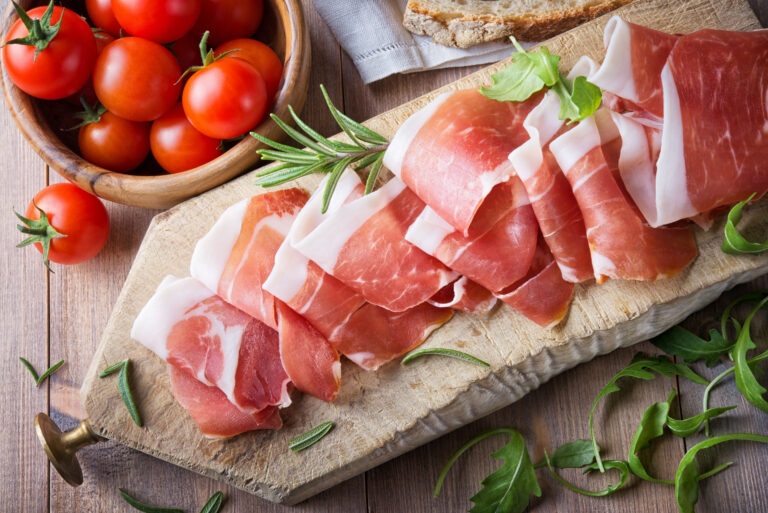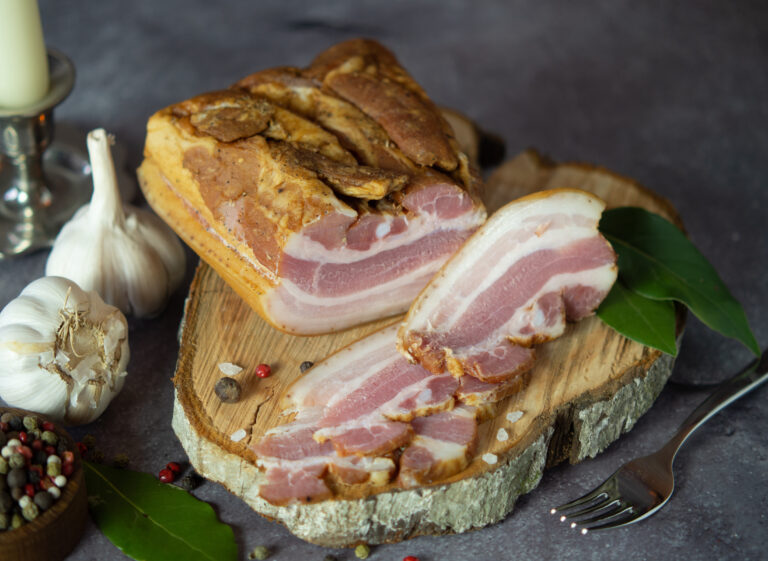10 Facts About Jamón Ibérico That Make It So Special
Jamon Iberico, a luxurious Spanish ham, derives from Iberian pigs with rich flavors. Bellota status signifies acorn-fed pigs for superior taste.
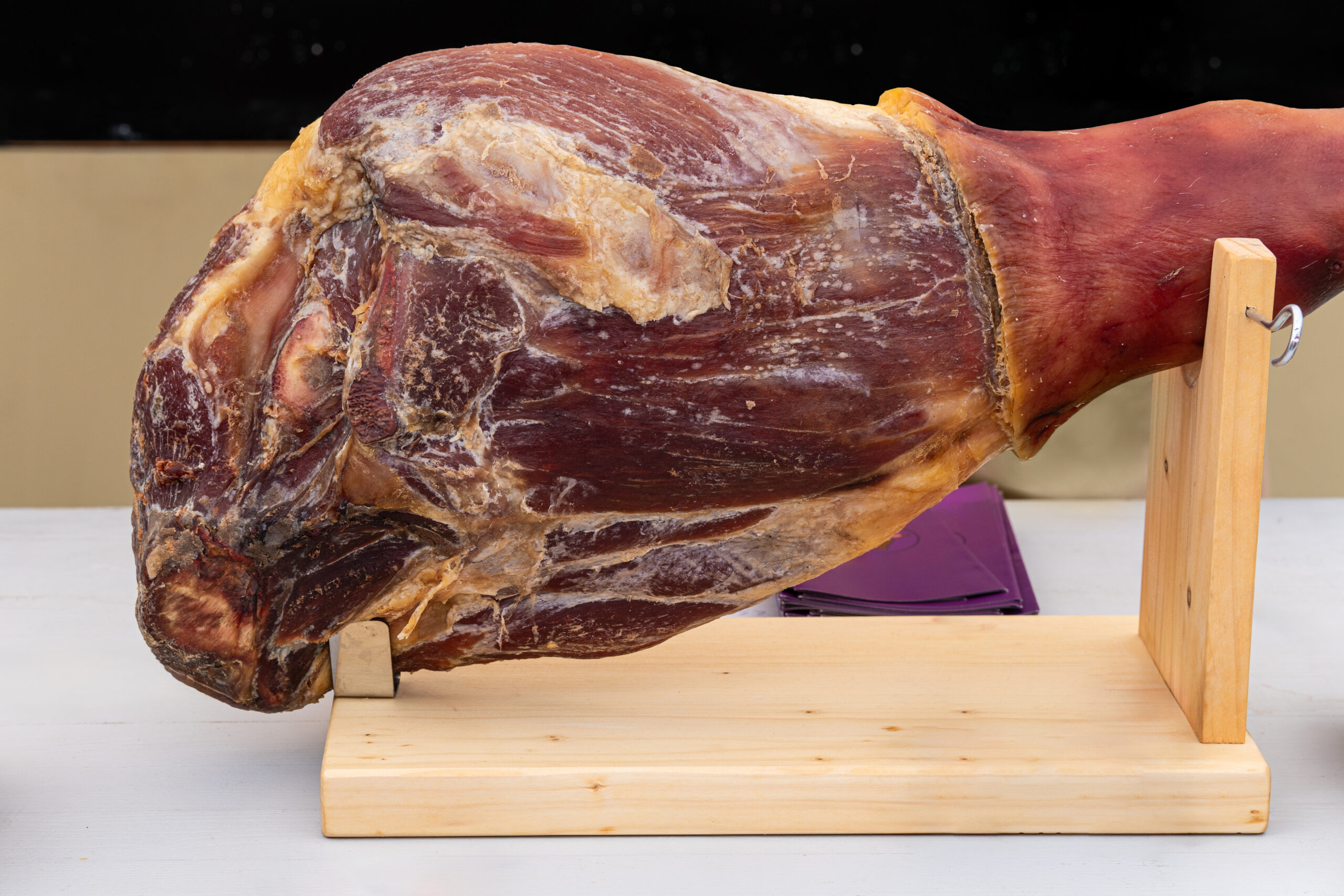
Jamón Ibérico, a luxurious Spanish delicacy, originates from the Iberian pig and is celebrated for its rich flavors and exceptional quality. The highest standard, Jamón Ibérico de Bellota, exemplifies this excellence.
Disclosure: As an Amazon Associate, this site earns from qualifying purchases. Thank you!
The Production Process of Jamón Ibérico
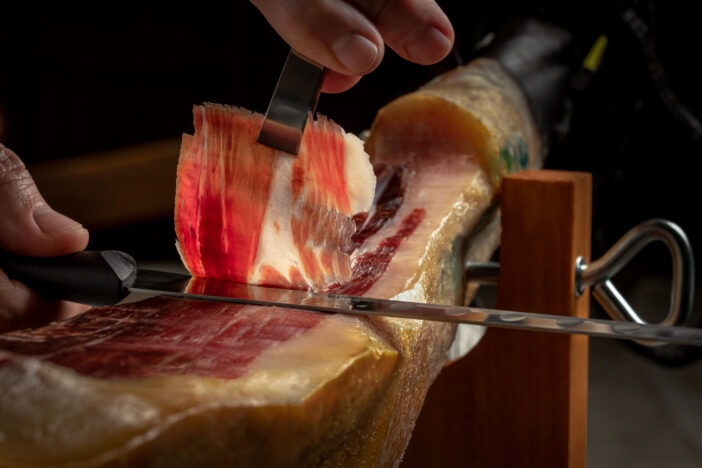
The production process of Jamón Ibérico is an intricate and time-honored tradition that yields one of the world’s most exclusive culinary delights. Understanding this process offers insight into the meticulous practices that set Jamón Ibérico apart from other cured meats.
The Role of The Dehesa: Natural Pastures
Jamón Ibérico starts in the Dehesa, vast pastures in southwest Spain where pigs roam freely. This free-range lifestyle contributes to their muscle development and the ham’s unique flavor and texture.
Acorns: The Secret Ingredient
During the montanera season, Iberian pigs feast on acorns rich in oleic acid, which infuses the meat with luxurious marbling and a melt-in-your-mouth texture. This acorn diet is crucial for the distinctive flavor of Jamón Ibérico de Bellota.
Traditional Curing Methods
The curing process is meticulous. Initially, hams rest in cool, humid conditions for dehydration. They then dry in well-ventilated areas, with traditional methods ensuring optimal conditions. Finally, hams age in cellars, with specialists inspecting each piece for readiness.
Classifications of Jamón Ibérico
The classification of Jamón Ibérico is primarily based on the breed purity of the pigs and their diets before processing, which influences the flavor, texture, and color of the ham. Here’s a simplified guide to the different labels:
- Black Label: 100% Iberico Acorn-Fed The black label, or “Pata Negra,” signifies the highest quality Jamón Ibérico de Bellota, made from 100% purebred Iberico pigs. These pigs roam freely in Dehesa meadows, feeding exclusively on acorns during the Montanera season, which imparts a rich, distinct flavor to the ham.
- Red Label: Acorn-Fed Iberico The red label denotes Jamón Ibérico de Bellota from crossbred pigs, typically 50% Iberico and 50% Duroc. These pigs also enjoy an acorn-rich diet in the Dehesa, resulting in a deep, enriched taste, although slightly different from the black label due to the mixed breed.
- Green Label: Pasture and Grain-Fed Iberico Jamón Ibérico de Cebo de Campo with a green label comes from pigs that are 50% Iberico and feed on both natural pastures and supplementary grains and legumes. These pigs have significant outdoor activity, leading to a ham that balances the nuttiness of acorns with traditional grain flavors.
- White Label: Grain-Fed Iberico The white label signifies Jamón Ibérico de Cebo, made from pigs fed exclusively on grains. These pigs are raised intensively with limited or no pasture access. This results in a milder flavor, making it an accessible entry point for exploring Iberico ham.
Each label of Jamón Ibérico offers a unique aspect of Spanish heritage, catering to a range of palates from the intense flavors of the black and red labels to the subtler tastes of the green and white labels.
How to Enjoy Jamón Ibérico
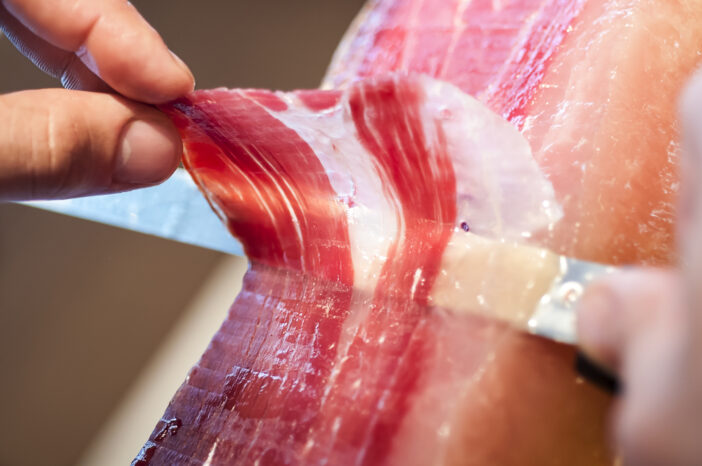
Proper Slicing Techniques
To fully enjoy Jamón Ibérico, mastering the art of slicing is essential. Use a long, sharp, flexible knife and secure the ham in a jamonero stand. Slices should be almost transparent, 1 to 2 inches long, and include both fat and meat for optimal flavor. Follow the ham’s contour, starting from the narrower part of the leg. When you reach the bone, switch to a shorter knife to carefully slice around it. This technique ensures minimal waste and maximum enjoyment.
Pairing with Wine and Sherry
Selecting the right beverage to accompany Jamón Ibérico enhances its flavors and creates a gourmet experience. A dry, aged Sherry like Fino or Manzanilla, with their crisp and nutty notes, pairs wonderfully with the rich ham. Medium-bodied reds with mild tannins, such as Rioja Reserva or Ribera del Duero, also complement the ham’s intensity. For a lighter option, try a dry, aromatic white wine or a chilled cava to highlight the ham’s delicate nutty and fruity flavors. Experiment with pairings to find what best suits your palate, making each tasting unique.
Preserving and Storing Jamón Ibérico
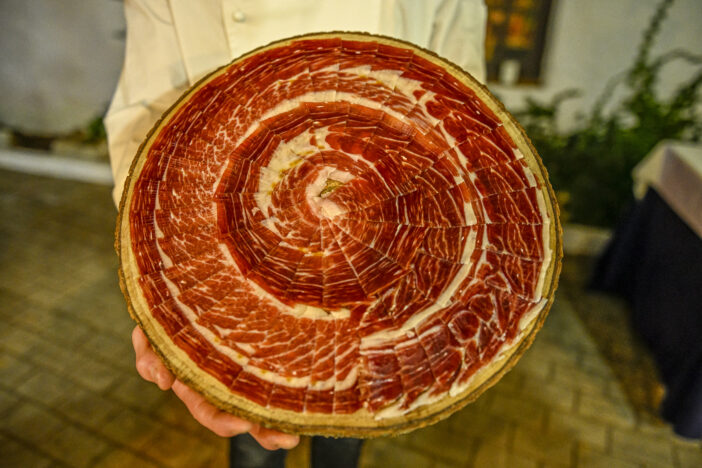
To maintain the exquisite flavor and texture of Jamón Ibérico, proper storage is essential. Here’s how to care for it:
- Vacuum-Packed Jamón Ibérico: Keep it refrigerated and consume it within a few days once opened.
- Whole Leg: Store in a cool, dry place like a pantry or cellar at 60°F to 75°F (15°C to 24°C). Avoid high humidity to prevent mold, and avoid overly dry conditions to maintain juiciness.
Preservation Tips:
- After slicing, cover the exposed area with slices of its own fat and a clean, breathable cloth to keep it fresh and flavorful.
- Regularly slice and consume the ham to prevent it from drying out, aiming to finish a whole leg within 2 to 3 months for the best quality.
Following these steps ensures your Jamón Ibérico remains a delectable highlight of your culinary experiences.
The Cost of Quality
Understanding the pricing of Jamón Ibérico involves recognizing the extensive care and resources required for its production. Iberian pigs, never genetically modified, are smaller and yield less meat than industrial pigs, producing a maximum of six offspring. They grow naturally without antibiotics or hormones, taking 12-18 months to reach ideal weight.
These pigs are raised free-range, requiring substantial land, which increases production costs. This meticulous approach ensures high animal welfare and contributes to the ham’s exceptional quality and flavor. The cost reflects these labor-intensive practices and the extensive land needed.
Jamón Ibérico is produced in designated geographical areas like DOP Dehesa de Extremadura and DOP Los Pedroches, known for their unique landscapes and ideal breeding conditions. These regions enhance the ham’s exclusivity and quality, with distinctive characteristics like the V-cut hams from Córdoba. The price of Jamón Ibérico reflects its unparalleled taste, craftsmanship, and commitment to sustainability and animal welfare.
In the video, Insider Food explains-
Insider Food
- Location and Prestige: Spanish Ibérico ham is produced in Cortegana, Sierra de Huelva in Andalusia, Spain, and is renowned as one of the most expensive meats globally.
- Special Breed: The ham comes from a special breed of pigs called the black Iberian pigs, known for their superior quality and taste, raised in the dehesa ecosystem.
- Historical Significance: Iberian pigs have been prized since ancient times, with references dating back to Roman times, and even Christopher Columbus had them aboard his voyages.
- Geographical Limitations: Production of Iberian ham is confined to specific regions in Spain, protected by the EU’s Protected Designation of Origin, ensuring authenticity and quality.
- Pure Breed Labeling: Only 6% of Iberian ham production is labeled with a black label, signifying it comes from 100% pure breed Iberian pigs.
- Feeding and Environment: Iberian pigs feed predominantly on acorns in the dehesa, which contributes to the unique flavor profile of the ham.
- Production Process: The hams undergo a meticulous curing process involving salting, controlled temperature rooms, and aging in cellars for up to several years.
- Variety of Cuts: Besides the traditional ham, other cuts like paleta (front leg) are also cured, and leftover meat is used for products like chorizo.
- Market Identification: Authentic Iberian ham can be identified by its soft texture, melt-in-the-mouth fat, and nutty flavor, often sourced from local specialty shops.
- Carving Technique and Taste: Carving Iberian ham requires skill, and the taste is characterized by its nuttiness, hint of acorn, tenderness due to less fat, and flavorful fat marbling.
Where to Buy Jamón Ibérico Online
In the United States, Jamón Ibérico is readily available online through specialized retailers. These platforms offer various options categorized by factors like feed type, curing duration, and rearing region in Spain. Detailed product descriptions help inform your choice, and most offer nationwide shipping. Some provide slicing and storage tips to maximize freshness. Subscription services and gift sets are also common, ensuring regular enjoyment or sharing of this delicacy. Look for retailers with direct relationships with Spanish producers for authenticity and quality assurance.
Frequently Asked Questions
Is Jamón Ibérico allowed in the US?
Yes, Jamón Ibérico is allowed in the US. Despite past regulations, there are now approved facilities in Spain that meet US standards, allowing the import of Jamón Ibérico. Consumers can purchase it through various online retailers offering authentic Spanish ham.
Does Trader Joe’s have Iberico Ham?
Yes, Trader Joe’s offers Iberico Ham. They have introduced Dry uncured acorn-fed Ibérico chorizo and Ibérico pork ham, providing high-quality cured meats from Spain for their customers.
Is Jamón Ibérico the same as prosciutto?
No, Jamón Ibérico and Prosciutto are not the same. Jamón Ibérico, from specific breeds of Iberian pigs, undergoes a longer curing process than Prosciutto. While Prosciutto is Italian, Jamón Ibérico is Spanish, each with distinct flavors and culinary traditions.
What is the best quality ham in the world?
Jamón Ibérico de bellota is considered the best quality ham in the world. This premium ham comes from free-range, acorn-fed Iberian pigs, known for its rich flavor and marbled texture, making it a highly prized delicacy.
Does Iberico ham taste like prosciutto?
Iberico ham does not taste like prosciutto; it has a richer and more intense flavor. Derived from a specific breed of pigs and their unique diet, Iberico ham offers a distinct taste experience, differentiating it from both prosciutto and other types of cured ham.

